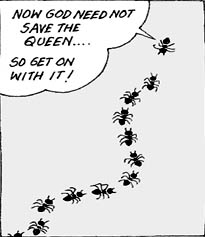A will where there is a hill
 in the case of most ants, a single fertile queen monopolises reproduction while the workers build the nest, nurse the offspring and forage for food. In some cases the nests built are quite elaborate and offer good protection from various environmental factors such as heat and floods. Sometimes, the nest represents such a heavy investment of time and effort that it seems a pity to abandon it after the death of the queen. Fortunately the queens in many species are fairly long-lived.
in the case of most ants, a single fertile queen monopolises reproduction while the workers build the nest, nurse the offspring and forage for food. In some cases the nests built are quite elaborate and offer good protection from various environmental factors such as heat and floods. Sometimes, the nest represents such a heavy investment of time and effort that it seems a pity to abandon it after the death of the queen. Fortunately the queens in many species are fairly long-lived.
However, in the case of ants with expensive nests and short-lived queens, the problem has found two different solutions. In the genera Formica and Camponotus , daughter queens returning after mating are accepted into their mothers' nests so that they can continue to use the painstakingly-built nest. On the other hand, the Indian ponerine ant Harpegnathus saltator , being studied by Peters and H
Related Content
- Order of the National Green Tribunal regarding illegal mining destroying Aravallis, 22/01/2025
- Order of the National Green Tribunal regarding encroachment and deforestation of Senchal Wildlife Sanctuary, 10/04/2024
- Order of the National Green Tribunal regarding solid waste dumping site, Darjeeling municipality, West Bengal, 18/03/2024
- Joint committee report on Aravali stone and sand mining in Haryana, 28/11/2022
- Order of the National Green Tribunal regarding illegal mining at Dadam Hills, Tosham, district Bhiwani, Haryana, 18/01/2022
- Order of the National Green Tribunal regarding Zonal Master Plan 2030 for the Mount Abu Eco-sensitive Zone, 10/03/2021
